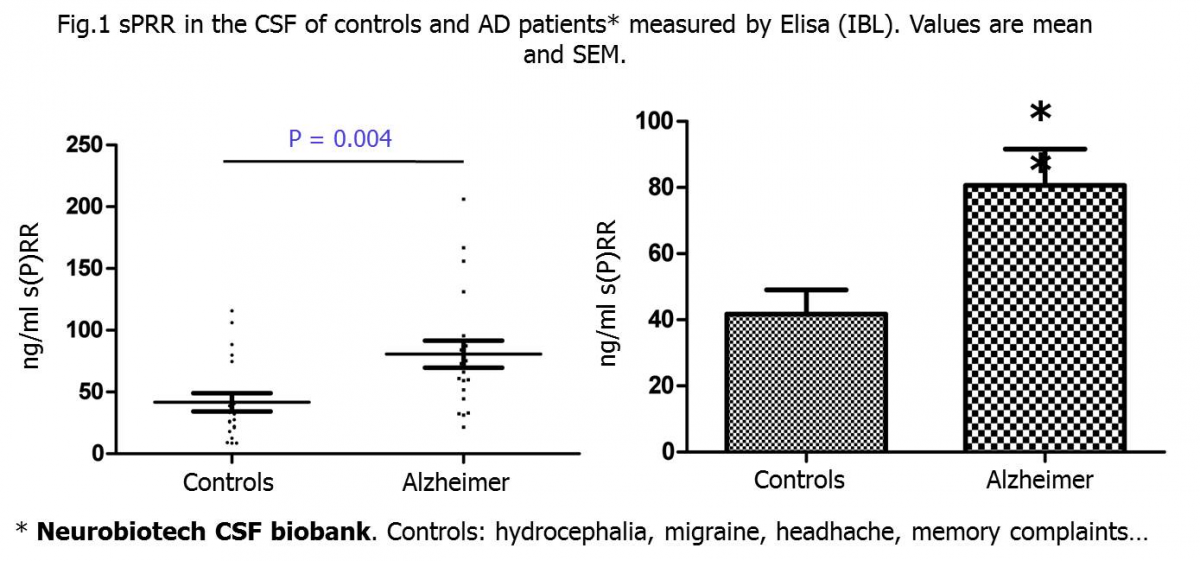sPRR as dual biomarker of neurodegeneration and neuroregeneration
Référence
04907-01
Statut des brevets
Priority patent application EP12305207.8 filed on February 22nd, 2012 entitled » New dual biomarkers of neurodegeneration and of neuroregeneration »


Inventeurs
Philippe MARIN
Eric THOUVENOT
Geneviève NGUYEN
Matthias GROSZER
Statut commercial
Exclusive or non-exclusive licenses or options, Collaborative agreement
Laboratoire
Institut de Génomique Fonctionnelle, a CNRS-INSERM-Université de Montepllier 1 laboratory (UMR 5203) in Montpellier, France.
Description
CONTEXT
The cerebrospinal fluid (CSF) is a sample of choice for biomarker discovery. However, proteomic approaches have been met with limited success due to the difficulty in identifying in CSF samples proteins that truly originate from neurons and that actually reflect neuronal dysfunction or death. Although apoptosis is a major mechanism of neuronal death in many neurodegenerative disorders, apoptotic neurons are often sparse in the brain of patients, making even more uncertain the identification of biomarkers of neuronal apoptosis in CSF.
Neuroregeneration, contrary to neurodegeneration, refers to the neuronal multiplication or differentiation or the synaptogenesis. Such mechanisms may include generation of new neurons, glia, axons, myelin, or synapses. So far, only a few biomarkers of neurogenesis are known.
The increasing frequency of neurodegenerative diseases and the lack of early and specific diagnostic and prognostic biomarkers necessitate the discovery of such new biomarkers of these diseases as well as biomarker for neurogenesis.
TECHNICAL DESCRIPTION
Stable isotope labeling by/with amino acids in cell culture (SILAC) is a technique based on mass spectrometry that detects differences in protein abundance among samples using non-radioactive isotopic labeling. Adapting this technique to detect neuronal secretome, Marin et al. have found that the extra cellular soluble part of the (pro)renin receptor (sPRR) was one of the proteins most differentially expressed in supernatants of apoptotic and surviving neurons.
Indeed, sPRR level was found elevated in conditioned medium of living neurons in culture, while decreased in the conditioned medium of dying neurons. Preliminary results from the co-inventors groups show that sPRR can be measured in CSF.

DEVELOPMENT STAGE
CSF from patients having various neurodegenerative diseases are currently being tested.
INDUSTRIAL APPLICATIONS
These biomarkers are to be used for the diagnostic and/or prognosis of neurodegenerative diseases, in particular Alzheimer’s disease, dementia with Lewy bodies, fronto-temporal dementia, Parkinson’s disease, amyotrophic lateral sclerosis, as well as for the follow up of neurodegenerative diseases treatments.
Conversely, they may be used for the diagnostic and/or prognosis of diseases implicating a neuronal proliferation, such as glioblastomas, as well as for the follow-up of their antiproliferative treatments.
Last, these biomarkers may be useful for the screening of new compounds liable to treat neurodegenerative diseases and to assess the efficacy of neuropsychiatric drugs.
For further information, please contact us (Ref 04907-01)